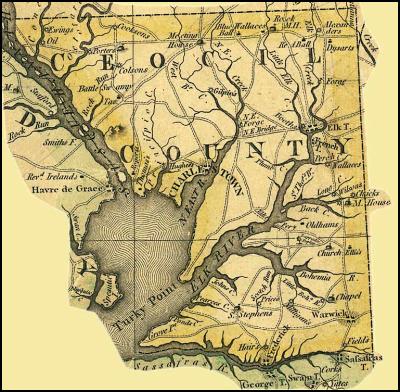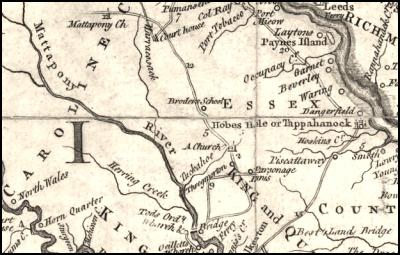
Cecil County Maryland, 1795

Part of Essex County and King and Queen County, Virginia
Francis Browning, c. 1673-1723, lived in Bristol, England, with grandmother, Hester Browning, following the deaths of his parents. [Bristol is on the boundary between Gloucestershire and Somerset in southwest England.]
In 1698, Francis Browning, son of John and Elizabeth Browning, appears in a Cecil County, Maryland, court record. (The court records for this period are unindexed.)
It is probable that Francis and Elizabeth Browning came to Maryland from Gloucestershire, England, at the same time. Their parents, John and Elizabeth Browning, were both deceased by 1690, therefore, these young Brownings were in their late teens or early twenties.
Francis married about in 1698 or 1699, first to Rachel Merritt (Marriott), and second to Mary, surname unknown. [The argument for a second marriage is not clear.]
His known children were Ann, 1699; Francis, 1700; John, 1702; Edmund or Edward, 1704; James, 1706; Thomas, 1708; William, 1710; and Nicholas, 1712. [Another account has John Browning, son of Francis Browning, born in about 1704 in Culpeper, Virginia.]
Families of ten to fifteen children were not unusual at this time in history, so it would be expected that other daughters were mixed in among the seven boys. Names of the daughters, except for Ann are unknown.
The dates of birth are circumstantial, but are consistent with other records of Brownings of this family.
Research confirms that the sons identified by E.F. Browning in Genealogy of the Brownings in America, 1908, can by verified, except for the use of the name Edward instead of Edmund. His descent from John of Jamestown is now considered incorrect.
In 1710, Francis Browning purchased two hundred acres on the southside of Portobago Creek in Essex County, Virginia, about twelve miles from an earlier location of Thomas and Ester Browning.
Francis Browning's Portobago land was adjacent to a tract owned by the Merritt family. There seems to also be a relationship between the Maryland Brownings and a Merritt family. It is possible that Rachel Browning was a Merritt. The name, Rachel, was also used by the Maryland family.
The name Merritt is in pre-1700 records in both Maryland and Virginia spelled "Merriott" or "Marriott," suggesting a French origin. This is consistent with the marriages between later Brownings and members of the Huguenot community.
In 1711, Francis Browning sold one hundred acres of his Portobago land to Joseph Calloway, with Rachel's consent.
In 1715, Francis Browning deeded the remaining one hundred acres of his Portobago land to his daughter, Ann, to be conveyed to her after his death. Ann could have been Francis and Rachel Browning's eldest child and still under age at the time this deed was executed.
Perhaps in about 1721, Francis Browning bought land from Larking Chew on the River Po, a branch of the Mattapony River in King and Queen County. The date of purchase has not been confirmed. King and Queen County records later burned.
This land became part of Spotsylvania County when it was established in 1721.
In 1724, Francis Browning, identified as being of St. Ann's Parish, Essex County, Virginia, sold his Spotsylvania land to Edward Rovvzee for forty pounds sterling.
[This cannot be the Francis Browning born in 1672 in Cecil County, Maryland, because that Francis Browning appears to have died in 1723. Perhaps this Francis Browning is the son born, by this account, in 1700, selling land that had belonged to his father.]

Cecil County Maryland, 1795

Part of Essex County and King and Queen County, Virginia